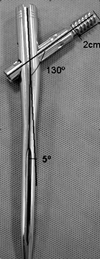Abstract
Purpose
To evaluate the radiographic and functional outcomes between who had unstable intertrochanteric fracture, treated with the ITST (lag screw design) and the PFNA (helical blade design).
Materials and Methods
We selected each 17 and 13 patients of unstable intertrochanteric fracture which were treated with ITST or PFNA from April 2005 to December 2008. We evaluated the radiographic results by follow-up radiography and the clinical outcomes with the mobility score of Parker and Palmer, Social function scoring system.
Results
The mean sliding distance of cervical screw with ITST nails was not shown significant differences than with using PFNA nails. The other factors were not statistically different. Decrease of mobility score of Parker and Palmer, Social function score were similar. 2 cases of cutting out was noted with ITST nails and 1 case of cutting out was noted with PFNA nails.
Figures and Tables
Fig. 1
The ITST (Zimmer) with lag screw. 2 cm of threaded lag screw length, 130° of neck-shaft angle, 5° of medial-lateral angle.

Fig. 2
The PFNA/II (Synthes) with a helical blade. 3 cm of helical blade length, 125° or 130° of neck-shaft angle, 6° of medial-lateral angle (PFNA)/5° of medial-lateral angle (PFNAII).

Fig. 3
(A) 66 years old male had unstable hip fracture by slip down. (B) Treated with ITST. (C) Cutting out by varus deformity. (D) Total hip replacement arthroplasty was done.

Fig. 4
(A) 76 years old female had unstable hip fracture by slip down. (B) Treated with ITST. (C) Cutting out. (D) Bipolar hemiarthroplasty was done.

References
1. Brunner A, Jöckel JA, Babst R. The PFNA proximal femur nail in treatment of unstable proximal femur fractures--3 cases of postoperative perforation of the helical blade into the hip joint. J Orthop Trauma. 2008. 22:731–736.

2. Fogagnolo F, Kfuri M Jr, Paccola CA. Intramedullary fixation of pertrochanteric hip fractures with the short AO-ASIF proximal femoral nail. Arch Orthop Trauma Surg. 2004. 124:31–37.

3. Harrington P, Nihal A, Singhania AK, Howell FR. Intramedullary hip screw versus sliding hip screw for unstable intertrochanteric femoral fractures in the elderly. Injury. 2002. 33:23–28.

4. Herrera A, Domingo J, Martinez A. Results of osteosynthesis with the ITST nail in fractures of the trochanteric region of the femur. Int Orthop. 2008. 32:767–772.

5. Hornby R, Evans JG, Vardon V. Operative or conservative treatment for trochanteric fractures of the femur. A randomised epidemiological trial in elderly patients. J Bone Joint Surg Br. 1989. 71:619–623.

6. Jensen JS. Determining factors for the mortality following hip fractures. Injury. 1984. 15:411–414.

7. Kyle RF, Cabanela ME, Russell TA, et al. Fractures of the proximal part of the femur. Instr Course Lect. 1995. 44:227–253.

8. Laros GS, Moore JF. Complications of fixation in intertrochanteric fractures. Clin Orthop Relat Res. 1974. 110–119.
9. Lenich A, Fierlbeck J, Al-Munajjed A, et al. First clinical and biomechanical results of the Trochanteric Fixation Nail (TFN). Technol Health Care. 2006. 14:403–409.

10. Madsen JE, Naess L, Aune AK, Alho A, Ekeland A, Strømsøe K. Dynamic hip screw with trochanteric stabilizing plate in the treatment of unstable proximal femoral fractures: a comparative study with the gamma nail and compression hip screw. J Orthop Trauma. 1998. 12:241–248.

11. Oh JK, Hwang JH. Osteoporotic pertrochanteric fracture: IM nailing. J Korean Fract Soc. 2009. 22:56–65.

12. Park JH, Park JW, Wang JH, Lee JW, Lee JI, Kim JG. Treatment of intertrochanteric fracture: comparison of ptoximal femoral nail and proximal femoral nail A. J Korean Fract Soc. 2008. 21:103–109.

13. Parker MJ, Palmer CR. A new mobility score for predicting mortality after hip fracture. J Bone Joint Surg Br. 1993. 75:797–798.

14. Sadowski C, Lübbeke A, Saudan M, Riand N, Stern R, Hoffmeyer P. Treatment of reverse oblique and transverse intertrochanteric fractures with use of an intramedullary nail or a 95 degrees screw-plate: a prospective, randomized study. J Bone Joint Surg Am. 2002. 84:372–381.

15. Saudan M, Lübbeke A, Sadowski C, Riand N, Stern R, Hoffmeyer P. Pertrochanteric fractures: is there an advantage to an intramedullary nail?: a randomized, prospective study of 206 patients comparing the dynamic hip screw and proximal femoral nail. J Orthop Trauma. 2002. 16:386–393.

16. Sommers MB, Roth C, Hall H, et al. A laboratory model to evaluate cutout resistance of implants for pertrochanteric fracture fixation. J Orthop Trauma. 2004. 18:361–368.





 PDF
PDF ePub
ePub Citation
Citation Print
Print








 XML Download
XML Download